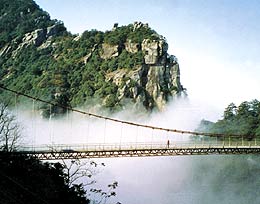
People wanting to get away from it all often return to nature, to relax in seclusion. Tourism authorities want to bring in the visitors as many as they can. How can this seeming contradiction be resolved? CCTV reporter Yang Lin takes you to Lushan Mountain to see how they're making the two ends meet.
Lushan Mountain in east China is very beautiful, covered with green trees and perpetually shrouded with mist.
Lushan Mountain is famous for its scenery and pleasantly cool summer temperatures. Throughout history, many famous poets and statesmen chose Lushan as a meeting place or built summer villas there.
But just a few months ago, a 24-meter high observation tower was at the top of the mountain, which spoilt the former natural beauty instead.
"We got rid of the observation tower to maintain the natural beauty of the mountain," said Ouyang Quanhua, director of Lushan Administrative Committee.
With tourism booming, local authorities had to develop facilities to make it more accessible and convenient. Investment was poured into construction projects, including a new lotus flower lake and cable cars and observation tower.
But not all the developments contributed to a more beautiful Lushan. Some natural scenic spots were obscured and former attractions which drew tourists were lost.
This led to a re-thinking of policy.
Ouyang said, "Environmental protection always has high priority over construction."
Local authorities have done a lot to maintain Lushan's natural charm. At great expense, a distillery was closed, unauthorized buildings were demolished and some sewage treatment facilities were built to help in protecting the environment and prevent pollution.
The authorities are also waking up to the fact that when people go traveling, they don't want to find themselves in crowded, unpleasant surroundings. Only an eco-friendly venue will keep visitors coming.
A Chinese tourist said, "Lushan is beautiful. It's a popular destination for tourists."
"So far, it looks good and the natural beauty is protected well," an American tourist said.
To make Lushan both well-protected and enticing, experts and professionals are being consulted for thorough, scientific planning.
A more beautiful Lushan is expected in the near future.
Tourism development and environmental protection are sometimes at odds with each other, but they don't need to be that way. Sustainable development in tourism and environmental protection can go hand in hand as is being demonstrated here.
(CCTV.com October 14, 2003)
|

